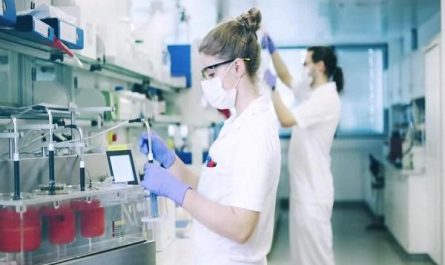These novel technologies have the potential to revolutionize how we diagnose and treat diseases. In this article, we will explore some of the most promising drug and gene delivery devices currently under research and development as well as their potential applications.
Nanoparticle Delivery Systems
At the microscopic level, nanotechnology is enabling the design of sophisticated drug carriers known as nanoparticles. Ranging from 1-100 nanometers in size, nanoparticles can be engineered to precisely deliver therapeutic payloads like drugs, proteins, or genes to target diseases. Some key types of nanoparticle delivery systems include:
– Liposomes: These spherical vesicles are made of lipid bilayers which can encapsulate both hydrophilic and hydrophobic drugs. Their biocompatible nature allows them to accumulate selectively in diseased tissues. Currently in clinical trials, liposomes show promise for cancer chemotherapy by delivering high drug concentrations directly to tumors.
– Dendrimers: Often described as “nano-sized trees”, dendrimers are precisely branched polymers that can be functionalized on their surface. This allows them to attach targeting ligands and encapsulate drug payloads. Their well-defined size and structure enables controlled drug release kinetics. Dendrimers have demonstrated potential for ocular gene therapy and treatment of neurodegenerative diseases.
– Inorganic nanoparticles: Nanoparticles made of metals, semiconductors or magnetic materials can serve as drug carriers. For instance, gold and iron oxide nanoparticles are being explored for their photothermal and magnetic properties in cancer thermal ablation and magnetic drug targeting, respectively.
Overall, nanoparticle systems hold great promise to enhance the efficacy of various drugs while reducing unwanted side effects by preferentially accumulating therapeutics in diseased tissues. Several nanoparticle formulations have already received FDA approval and more are in advanced clinical trials for applications like cancer chemotherapy.
Implantable Drug Pumps
Implantable Drug and Gene Delivery Devices provide a controlled method for long-term drug administration. Rather than recurrent injections, these pumps can continuously infuse precise doses of medications over extended periods of time. Some key implantable pump technologies include:
– Intrathecal pumps: Used to administer drugs directly into the fluid surrounding the spinal cord (intrathecally), these pumps are typically implanted to provide long-term pain relief or treat spasticity. Programmable pumps can deliver customized dose schedules tailored to each patient.
– Infusion ports: Implanted ports with access catheters provide a surgically implanted reservoir to infuse drugs systematically. They enable outpatient therapy while avoiding the discomfort of multiple IV insertions. Common applications include chemotherapy, parenteral nutrition, and IV antibiotic treatment.
– Biosensors and feedback systems: Advanced “closed-loop” pumps incorporate real-time biosensors to monitor biomarker levels and automatically adjust drug delivery accordingly. This helps maintain therapeutic drug concentrations more precisely for conditions like diabetes, Parkinson’s disease, and epilepsy.
By delivering drugs continuously via implanted catheters and reservoirs, these pump technologies have transformed the treatment of chronic pain, spasticity, and other long-term conditions traditionally managed through recurrent clinic or hospital visits. Further miniaturization may allow more widespread clinical use.
Injectable Hydrogels
Injectable hydrogels are a promising class of biomaterials for localized drug delivery applications. Made primarily of water, they can be injected through small gauge needles as liquids but transition into gel forms once in tissues or body cavities. Some key injectable hydrogel technologies in development include:
– Thermosensitive hydrogels: These gels undergo sol-gel phase transitions in response to physiological temperature. Materials like poloxamer 407 and pluronic F-127 solutions remain liquid when cool but gelify upon injection, enabling minimally invasive placement and localized drug release.
– In-situ crosslinking hydrogels: Hydrogels formed through polymer crosslinking reactions initiated within the body. For instance, thiolated PEG-based precursors gel rapidly upon exposure to tissue nucleophiles like thiol groups. This facilitates conformal adhesion to irregular defect sites for guided tissue regeneration applications.
– Self-assembling peptides: Short peptide sequences can self-assemble into beta-sheet dominated hydrogel nanofibers responding to physiological cues. RADA16 and P11 peptides show wound healing and angiogenic activity both alone and to deliver growth factors for regenerative therapies.
As soft, biocompatible materials mimicking natural extracellular matrices, injectable hydrogels show promise as versatile localized drug and cell delivery platforms. Minimally invasive administration as liquids makes them convenient for various clinical applications from ophthalmology to orthopedics.
Gene Delivery Vectors
Finally, gene therapy holds promise to treat previously untreatable genetic disorders through targeted gene delivery. While viral vectors like retroviruses have been most widely investigated, safety concerns remain over potential carcinogenesis. Current research focuses on developing safer and more efficient non-viral vectors such as:
– Exosomes: Naturally secreted extracellular vesicles may serve as Trojan horses to ferry therapeutic nucleic acids across biological barriers. Modification of exosome cargo and targeting moieties hold potential as non-immunogenic vehicles.
– Synthetic polymers: Cationic polymers like polyethyleneimine complex and condense DNA/RNA through electrostatic interactions, protecting them from degradation while facilitating cellular uptake. However, endosomal entrapment limits cytosolic gene expression.
– Minicircles: Supercoiled DNA minicircles lacking bacterial backbone sequences achieve higher nuclear localization and expression compared to plasmids. Intramuscular injection shows promise for Duchenne Muscular Dystrophy gene therapy.
Overall, continued developments in delivery vectors hold promise to realize the full potential of gene therapy for genetic, infectious, and acquired diseases. Balancing safety, efficacy, targeting ability and scalability remains an active area of research.
In closing, drug and gene delivery represents a highly interdisciplinary field combining advances in biomaterials, nanotechnology, tissue engineering and pharmacology. Careful device design enables controlled release kinetics tuned to therapeutic needs. Looking ahead, further developments may allow entirely implantable bioresorbable delivery systems activating tissue regeneration in situ. Overall, the next decade promises to bring many innovative drug and gene carriers from research into approved clinical use, revolutionizing disease treatment paradigms.
Note:
1. Source: Coherent Market Insights, Public sources, Desk research
2. We have leveraged AI tools to mine information and compile it




